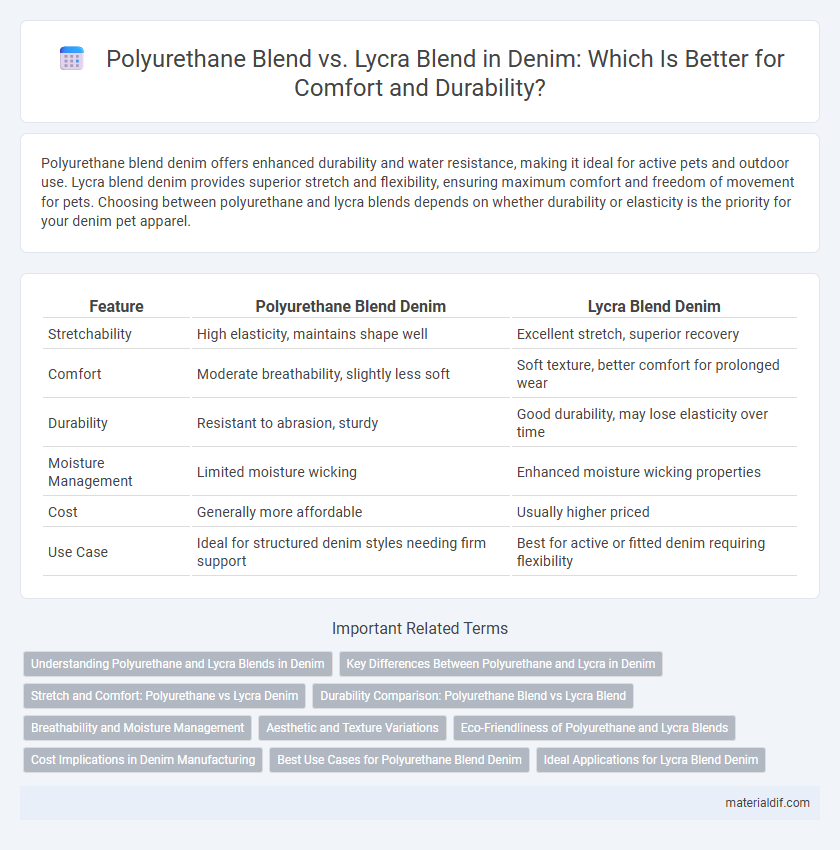Polyurethane blend denim offers enhanced durability and water resistance, making it ideal for active pets and outdoor use. Lycra blend denim provides superior stretch and flexibility, ensuring maximum comfort and freedom of movement for pets. Choosing between polyurethane and lycra blends depends on whether durability or elasticity is the priority for your denim pet apparel.
Table of Comparison
| Feature | Polyurethane Blend Denim | Lycra Blend Denim |
|---|---|---|
| Stretchability | High elasticity, maintains shape well | Excellent stretch, superior recovery |
| Comfort | Moderate breathability, slightly less soft | Soft texture, better comfort for prolonged wear |
| Durability | Resistant to abrasion, sturdy | Good durability, may lose elasticity over time |
| Moisture Management | Limited moisture wicking | Enhanced moisture wicking properties |
| Cost | Generally more affordable | Usually higher priced |
| Use Case | Ideal for structured denim styles needing firm support | Best for active or fitted denim requiring flexibility |
Understanding Polyurethane and Lycra Blends in Denim
Polyurethane blends in denim provide enhanced durability and water resistance due to the polymer's strong elastic properties, making jeans more resistant to wear and tear. Lycra blends, composed of spandex fibers, offer superior stretch and recovery, ensuring comfort and flexibility in form-fitting denim styles. Choosing between polyurethane and Lycra blends depends on the desired balance of durability, elasticity, and comfort in denim garments.
Key Differences Between Polyurethane and Lycra in Denim
Polyurethane blend denim offers superior water resistance and enhanced durability due to its synthetic elastomer properties, making it ideal for heavy-duty use. Lycra blend denim provides exceptional stretch and shape retention with its elastane fibers, ensuring greater comfort and flexibility in everyday wear. While polyurethane enhances fabric toughness, Lycra prioritizes elasticity and breathability, influencing performance and user experience in denim garments.
Stretch and Comfort: Polyurethane vs Lycra Denim
Polyurethane blend denim offers exceptional stretch and durability, maintaining shape retention over time due to its elastic recovery properties. Lycra blend denim provides superior softness and flexibility, enhancing wearer comfort with its lightweight and breathable nature. Both fabrics improve fit and mobility, but Lycra excels in comfort while polyurethane emphasizes resilience and long-lasting stretch.
Durability Comparison: Polyurethane Blend vs Lycra Blend
Polyurethane blends in denim offer superior durability due to their high resistance to abrasion and enhanced elasticity, extending the fabric's lifespan under frequent wear. Lycra blends provide excellent stretch and recovery but tend to lose elasticity faster over time, which may lead to fiber breakdown and reduced durability. Choosing polyurethane blends ensures longer-lasting denim performance, especially in high-stress areas prone to frequent movement.
Breathability and Moisture Management
Polyurethane blend denim offers enhanced moisture management due to its water-resistant properties, effectively repelling sweat and keeping the fabric dry. Lycra blend denim excels in breathability, allowing better air circulation that helps maintain comfort during extended wear. Both blends improve stretch and fit, but Lycra is preferred for superior ventilation, while polyurethane prioritizes moisture-wicking performance.
Aesthetic and Texture Variations
Polyurethane blend denim offers a glossy, smooth finish with enhanced stretch and recovery, providing a sleek, modern aesthetic ideal for form-fitting styles. Lycra blend denim delivers a matte, soft texture with superior flexibility and breathability, resulting in a natural look that maintains comfort over long wear. Differences in fiber composition significantly affect fabric hand feel, sheen, and garment drape, influencing design choices in denim fashion.
Eco-Friendliness of Polyurethane and Lycra Blends
Polyurethane blends in denim offer enhanced durability and elasticity while often incorporating eco-friendlier production methods, such as water-based polyurethane coatings that reduce harmful emissions. Lycra blends, although providing superior stretch and comfort, typically involve more energy-intensive manufacturing processes and synthetic materials that pose greater environmental challenges. Choosing polyurethane blends can lead to a lower carbon footprint and less environmental impact, making them a more sustainable option in denim fabric technology.
Cost Implications in Denim Manufacturing
Polyurethane blend denim typically incurs higher production costs due to the material's elasticity and durability, which enhance garment lifespan and consumer value. Lycra blend denim offers a cost-effective alternative with sufficient stretch and comfort but may sacrifice some durability and wear resistance. Manufacturers often weigh the premium pricing of polyurethane blends against the economic benefits of Lycra blends to optimize product pricing and market positioning.
Best Use Cases for Polyurethane Blend Denim
Polyurethane blend denim offers superior stretch and recovery, making it ideal for activewear and form-fitting jeans that require flexibility and durability. This blend enhances fabric resilience against wear and tear, perfect for high-performance denim in workwear and everyday casual styles. Polyurethane-infused denim also maintains shape retention after multiple washes, ensuring longevity in garments designed for frequent use.
Ideal Applications for Lycra Blend Denim
Lycra blend denim offers superior stretch and shape retention, making it ideal for skinny jeans, jeggings, and form-fitting apparel where comfort and flexibility are essential. This blend enhances fabric durability while maintaining softness, perfect for activewear and fashion-forward designs requiring a snug fit. Lycra-infused denim adapts well to body movements, making it suitable for everyday wear and performance-driven clothing.
Polyurethane Blend vs Lycra Blend Infographic

 materialdif.com
materialdif.com